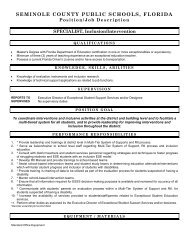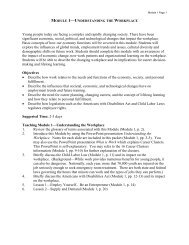- Page 1:
SEMINOLECOUNTYPUBLIC SCHOOLSSchool
- Page 7 and 8:
district, Seminole County Public Sc
- Page 9 and 10:
schools lends even more support for
- Page 11 and 12:
% F/RStudents% Non-F/RStudentsTable
- Page 13 and 14:
QUALITY OF PROJECT DESIGNSeminole C
- Page 15 and 16:
qualified forpreparation oflow-inco
- Page 17:
Through business partnerships with
- Page 20 and 21:
(3) Access to and Participation in
- Page 22 and 23:
inclusion in the project are AP Com
- Page 24 and 25:
studies, teachers will receive firs
- Page 26 and 27:
Education, to provide regular infor
- Page 28 and 29:
Objective 1.3. By July2014, transfo
- Page 30 and 31:
provided through theproject.Objecti
- Page 32 and 33:
In addition to the existing staff,
- Page 34 and 35:
BUDGET NARRATIVEItemPersonnelDescri
- Page 36 and 37:
ItemSubstitutes - Benefit rate, 1.4
- Page 38:
Other AttachmentsTable of ContentsA
- Page 41 and 42:
Other Attachments 36Page 40
- Page 43 and 44:
Eligibility by Feeder Pattern - Lym
- Page 45 and 46:
Walt Griffin407-366-0537 (h) 407-32
- Page 47 and 48:
SEMINOLE COUNTY PUBLIC SCHOOLS, FLO
- Page 49 and 50:
SEMINOLE COUNTY PUBLIC SCHOOLSJob D
- Page 51 and 52: Other Attachments 46Page 50
- Page 53 and 54: Letter of SupportCollege Board, Sou
- Page 55 and 56: I am confident that this project wi
- Page 57 and 58: THE SCHOOL BOARD OF SEMINOLE COUNTY
- Page 59 and 60: Date:Bid Number:Bid Title:THE SCHOO
- Page 61 and 62: EXT. PRICE (50)PROJ. INSTALL:31+ UN
- Page 63 and 64: 21-Elmo #CO-10 - #4M38008 (microsco
- Page 65 and 66: THE SCHOOL BOARD OF SEMINOLE COUNTY
- Page 67 and 68: THE SCHOOL BOARD OF SEMINOLE COUNTY
- Page 69 and 70: THE SCHOOL BOARD OF SEMINOLE COUNTY
- Page 71 and 72: THE SCHOOL BOARD OF SEMINOLE COUNTY
- Page 73 and 74: THE SCHOOL BOARD OF SEMINOLE COUNTY
- Page 75 and 76: THE SCHOOL BOARD OF SEMINOLE COUNTY
- Page 77 and 78: Page 76
- Page 79 and 80: Page 78
- Page 81 and 82: THE SCHOOL BOARD OF SEMINOLE COUNTY
- Page 83 and 84: THE SCHOOL BOARD OF SEMINOLE COUNTY
- Page 85 and 86: To:Board MembersBILL VOGEL, Ed.D.Su
- Page 87 and 88: THE SCHOOL BOARD OF SEMINOLE COUNTY
- Page 89 and 90: EDUCATIONAL PLANT FIVE YEAR SURVEYR
- Page 91 and 92: EDUCATIONAL PLANT FIVE YEAR SURVEY
- Page 93 and 94: EDUCATIONAL PLANT FIVE YEAR SURVEY
- Page 95 and 96: EDUCATIONAL PLANT FIVE YEAR SURVEY
- Page 97 and 98: EDUCATIONAL PLANT FIVE YEAR SURVEY
- Page 99 and 100: EDUCATIONAL PLANT FIVE YEAR SURVEY
- Page 101: EDUCATIONAL PLANT FIVE YEAR SURVEY
- Page 105 and 106: EDUCATIONAL PLANT FIVE YEAR SURVEY
- Page 107 and 108: EDUCATIONAL PLANT FIVE YEAR SURVEY
- Page 109 and 110: EDUCATIONAL PLANT FIVE YEAR SURVEY
- Page 111 and 112: EDUCATIONAL PLANT FIVE YEAR SURVEY
- Page 113 and 114: EDUCATIONAL PLANT FIVE YEAR SURVEY
- Page 115 and 116: EDUCATIONAL PLANT FIVE YEAR SURVEY
- Page 117 and 118: EDUCATIONAL PLANT FIVE YEAR SURVEY
- Page 119 and 120: EDUCATIONAL PLANT FIVE YEAR SURVEY
- Page 121 and 122: EDUCATIONAL PLANT FIVE YEAR SURVEY
- Page 123 and 124: EDUCATIONAL PLANT FIVE YEAR SURVEY
- Page 125 and 126: EDUCATIONAL PLANT FIVE YEAR SURVEY
- Page 127 and 128: EDUCATIONAL PLANT FIVE YEAR SURVEY
- Page 129 and 130: EDUCATIONAL PLANT FIVE YEAR SURVEY
- Page 131 and 132: EDUCATIONAL PLANT FIVE YEAR SURVEY
- Page 133 and 134: EDUCATIONAL PLANT FIVE YEAR SURVEY
- Page 135 and 136: EDUCATIONAL PLANT FIVE YEAR SURVEY
- Page 137 and 138: EDUCATIONAL PLANT FIVE YEAR SURVEY
- Page 139 and 140: EDUCATIONAL PLANT FIVE YEAR SURVEY
- Page 141 and 142: EDUCATIONAL PLANT FIVE YEAR SURVEY
- Page 143 and 144: EDUCATIONAL PLANT FIVE YEAR SURVEY
- Page 145 and 146: EDUCATIONAL PLANT FIVE YEAR SURVEY
- Page 147 and 148: EDUCATIONAL PLANT FIVE YEAR SURVEY
- Page 149 and 150: EDUCATIONAL PLANT FIVE YEAR SURVEY
- Page 151 and 152: EDUCATIONAL PLANT FIVE YEAR SURVEY
- Page 153 and 154:
EDUCATIONAL PLANT FIVE YEAR SURVEY
- Page 155 and 156:
EDUCATIONAL PLANT FIVE YEAR SURVEY
- Page 157 and 158:
EDUCATIONAL PLANT FIVE YEAR SURVEY
- Page 159 and 160:
EDUCATIONAL PLANT FIVE YEAR SURVEY
- Page 161 and 162:
EDUCATIONAL PLANT FIVE YEAR SURVEY
- Page 163 and 164:
EDUCATIONAL PLANT FIVE YEAR SURVEY
- Page 165 and 166:
EDUCATIONAL PLANT FIVE YEAR SURVEY
- Page 167 and 168:
EDUCATIONAL PLANT FIVE YEAR SURVEY
- Page 169 and 170:
EDUCATIONAL PLANT FIVE YEAR SURVEY
- Page 171 and 172:
EDUCATIONAL PLANT FIVE YEAR SURVEY
- Page 173 and 174:
EDUCATIONAL PLANT FIVE YEAR SURVEY
- Page 175 and 176:
EDUCATIONAL PLANT FIVE YEAR SURVEY
- Page 177 and 178:
EDUCATIONAL PLANT FIVE YEAR SURVEY
- Page 179 and 180:
EDUCATIONAL PLANT FIVE YEAR SURVEY
- Page 181 and 182:
EDUCATIONAL PLANT FIVE YEAR SURVEY
- Page 183 and 184:
EDUCATIONAL PLANT FIVE YEAR SURVEY
- Page 185 and 186:
EDUCATIONAL PLANT FIVE YEAR SURVEY
- Page 187 and 188:
EDUCATIONAL PLANT FIVE YEAR SURVEY
- Page 189 and 190:
EDUCATIONAL PLANT FIVE YEAR SURVEY
- Page 191 and 192:
EDUCATIONAL PLANT FIVE YEAR SURVEY
- Page 193 and 194:
EDUCATIONAL PLANT FIVE YEAR SURVEY
- Page 195 and 196:
EDUCATIONAL PLANT FIVE YEAR SURVEY
- Page 197 and 198:
EDUCATIONAL PLANT FIVE YEAR SURVEY
- Page 199 and 200:
EDUCATIONAL PLANT FIVE YEAR SURVEY
- Page 201 and 202:
EDUCATIONAL PLANT FIVE YEAR SURVEY
- Page 203 and 204:
EDUCATIONAL PLANT FIVE YEAR SURVEY
- Page 205 and 206:
EDUCATIONAL PLANT FIVE YEAR SURVEY
- Page 207 and 208:
EDUCATIONAL PLANT FIVE YEAR SURVEY
- Page 209 and 210:
EDUCATIONAL PLANT FIVE YEAR SURVEY
- Page 211 and 212:
EDUCATIONAL PLANT FIVE YEAR SURVEY
- Page 213 and 214:
EDUCATIONAL PLANT FIVE YEAR SURVEY
- Page 215 and 216:
EDUCATIONAL PLANT FIVE YEAR SURVEY
- Page 217 and 218:
EDUCATIONAL PLANT FIVE YEAR SURVEY
- Page 219 and 220:
EDUCATIONAL PLANT FIVE YEAR SURVEY
- Page 221 and 222:
EDUCATIONAL PLANT FIVE YEAR SURVEY
- Page 223 and 224:
EDUCATIONAL PLANT FIVE YEAR SURVEY
- Page 225 and 226:
EDUCATIONAL PLANT FIVE YEAR SURVEY
- Page 227 and 228:
EDUCATIONAL PLANT FIVE YEAR SURVEY
- Page 229 and 230:
EDUCATIONAL PLANT FIVE YEAR SURVEY
- Page 231 and 232:
EDUCATIONAL PLANT FIVE YEAR SURVEY
- Page 233 and 234:
EDUCATIONAL PLANT FIVE YEAR SURVEY
- Page 235 and 236:
EDUCATIONAL PLANT FIVE YEAR SURVEY
- Page 237 and 238:
EDUCATIONAL PLANT FIVE YEAR SURVEY
- Page 239 and 240:
EDUCATIONAL PLANT FIVE YEAR SURVEY
- Page 241 and 242:
EDUCATIONAL PLANT FIVE YEAR SURVEY
- Page 243 and 244:
EDUCATIONAL PLANT FIVE YEAR SURVEY
- Page 245 and 246:
EDUCATIONAL PLANT FIVE YEAR SURVEY
- Page 247 and 248:
EDUCATIONAL PLANT FIVE YEAR SURVEY
- Page 249 and 250:
EDUCATIONAL PLANT FIVE YEAR SURVEY
- Page 251 and 252:
EDUCATIONAL PLANT FIVE YEAR SURVEY
- Page 253 and 254:
EDUCATIONAL PLANT FIVE YEAR SURVEY
- Page 255 and 256:
EDUCATIONAL PLANT FIVE YEAR SURVEY
- Page 257 and 258:
EDUCATIONAL PLANT FIVE YEAR SURVEY
- Page 259 and 260:
EDUCATIONAL PLANT FIVE YEAR SURVEY
- Page 261 and 262:
EDUCATIONAL PLANT FIVE YEAR SURVEY
- Page 263 and 264:
EDUCATIONAL PLANT FIVE YEAR SURVEY
- Page 265 and 266:
EDUCATIONAL PLANT FIVE YEAR SURVEY
- Page 267 and 268:
EDUCATIONAL PLANT FIVE YEAR SURVEY
- Page 269 and 270:
EDUCATIONAL PLANT FIVE YEAR SURVEY
- Page 271 and 272:
EDUCATIONAL PLANT FIVE YEAR SURVEY
- Page 273 and 274:
EDUCATIONAL PLANT FIVE YEAR SURVEY
- Page 275 and 276:
EDUCATIONAL PLANT FIVE YEAR SURVEY
- Page 277 and 278:
EDUCATIONAL PLANT FIVE YEAR SURVEY
- Page 279 and 280:
EDUCATIONAL PLANT FIVE YEAR SURVEY
- Page 281 and 282:
EDUCATIONAL PLANT FIVE YEAR SURVEY
- Page 283 and 284:
EDUCATIONAL PLANT FIVE YEAR SURVEY
- Page 285 and 286:
EDUCATIONAL PLANT FIVE YEAR SURVEY
- Page 287 and 288:
EDUCATIONAL PLANT FIVE YEAR SURVEY
- Page 289 and 290:
EDUCATIONAL PLANT FIVE YEAR SURVEY
- Page 291 and 292:
EDUCATIONAL PLANT FIVE YEAR SURVEY
- Page 293 and 294:
EDUCATIONAL PLANT FIVE YEAR SURVEY
- Page 295 and 296:
EDUCATIONAL PLANT FIVE YEAR SURVEY
- Page 297 and 298:
EDUCATIONAL PLANT FIVE YEAR SURVEY
- Page 299 and 300:
EDUCATIONAL PLANT FIVE YEAR SURVEY
- Page 301 and 302:
EDUCATIONAL PLANT FIVE YEAR SURVEY
- Page 303 and 304:
EDUCATIONAL PLANT FIVE YEAR SURVEY
- Page 305 and 306:
EDUCATIONAL PLANT FIVE YEAR SURVEY
- Page 307 and 308:
EDUCATIONAL PLANT FIVE YEAR SURVEY
- Page 309 and 310:
EDUCATIONAL PLANT FIVE YEAR SURVEY
- Page 311 and 312:
EDUCATIONAL PLANT FIVE YEAR SURVEY
- Page 313 and 314:
EDUCATIONAL PLANT FIVE YEAR SURVEY
- Page 315 and 316:
EDUCATIONAL PLANT FIVE YEAR SURVEY
- Page 317 and 318:
EDUCATIONAL PLANT FIVE YEAR SURVEY
- Page 319 and 320:
EDUCATIONAL PLANT FIVE YEAR SURVEY
- Page 321 and 322:
EDUCATIONAL PLANT FIVE YEAR SURVEY
- Page 323 and 324:
EDUCATIONAL PLANT FIVE YEAR SURVEY
- Page 325 and 326:
EDUCATIONAL PLANT FIVE YEAR SURVEY
- Page 327 and 328:
EDUCATIONAL PLANT FIVE YEAR SURVEY
- Page 329 and 330:
EDUCATIONAL PLANT FIVE YEAR SURVEY
- Page 331 and 332:
EDUCATIONAL PLANT FIVE YEAR SURVEY
- Page 333 and 334:
EDUCATIONAL PLANT FIVE YEAR SURVEY
- Page 335 and 336:
EDUCATIONAL PLANT FIVE YEAR SURVEY
- Page 337 and 338:
EDUCATIONAL PLANT FIVE YEAR SURVEY
- Page 339 and 340:
EDUCATIONAL PLANT FIVE YEAR SURVEY
- Page 341 and 342:
EDUCATIONAL PLANT FIVE YEAR SURVEY
- Page 343 and 344:
EDUCATIONAL PLANT FIVE YEAR SURVEY
- Page 345 and 346:
EDUCATIONAL PLANT FIVE YEAR SURVEY
- Page 347 and 348:
EDUCATIONAL PLANT FIVE YEAR SURVEY
- Page 349 and 350:
EDUCATIONAL PLANT FIVE YEAR SURVEY
- Page 351 and 352:
EDUCATIONAL PLANT FIVE YEAR SURVEY
- Page 353 and 354:
EDUCATIONAL PLANT FIVE YEAR SURVEY
- Page 355 and 356:
EDUCATIONAL PLANT FIVE YEAR SURVEY
- Page 357 and 358:
EDUCATIONAL PLANT FIVE YEAR SURVEY
- Page 359 and 360:
EDUCATIONAL PLANT FIVE YEAR SURVEY
- Page 361 and 362:
EDUCATIONAL PLANT FIVE YEAR SURVEY
- Page 363 and 364:
EDUCATIONAL PLANT FIVE YEAR SURVEY
- Page 365 and 366:
EDUCATIONAL PLANT FIVE YEAR SURVEY
- Page 367 and 368:
EDUCATIONAL PLANT FIVE YEAR SURVEY
- Page 369 and 370:
EDUCATIONAL PLANT FIVE YEAR SURVEY
- Page 371 and 372:
EDUCATIONAL PLANT FIVE YEAR SURVEY
- Page 373 and 374:
EDUCATIONAL PLANT FIVE YEAR SURVEY
- Page 375 and 376:
EDUCATIONAL PLANT FIVE YEAR SURVEY
- Page 377 and 378:
EDUCATIONAL PLANT FIVE YEAR SURVEY
- Page 379 and 380:
EDUCATIONAL PLANT FIVE YEAR SURVEY
- Page 381 and 382:
EDUCATIONAL PLANT FIVE YEAR SURVEY
- Page 383 and 384:
EDUCATIONAL PLANT FIVE YEAR SURVEY
- Page 385 and 386:
EDUCATIONAL PLANT FIVE YEAR SURVEY
- Page 387 and 388:
EDUCATIONAL PLANT FIVE YEAR SURVEY
- Page 389 and 390:
EDUCATIONAL PLANT FIVE YEAR SURVEY
- Page 391 and 392:
EDUCATIONAL PLANT FIVE YEAR SURVEY
- Page 393 and 394:
EDUCATIONAL PLANT FIVE YEAR SURVEY
- Page 395 and 396:
EDUCATIONAL PLANT FIVE YEAR SURVEY
- Page 397 and 398:
EDUCATIONAL PLANT FIVE YEAR SURVEY
- Page 399 and 400:
EDUCATIONAL PLANT FIVE YEAR SURVEY
- Page 401 and 402:
EDUCATIONAL PLANT FIVE YEAR SURVEY
- Page 403 and 404:
EDUCATIONAL PLANT FIVE YEAR SURVEY
- Page 405 and 406:
EDUCATIONAL PLANT FIVE YEAR SURVEY
- Page 407 and 408:
EDUCATIONAL PLANT FIVE YEAR SURVEY
- Page 409 and 410:
EDUCATIONAL PLANT FIVE YEAR SURVEY
- Page 411 and 412:
EDUCATIONAL PLANT FIVE YEAR SURVEY
- Page 413 and 414:
EDUCATIONAL PLANT FIVE YEAR SURVEY
- Page 415 and 416:
EDUCATIONAL PLANT FIVE YEAR SURVEY
- Page 417 and 418:
EDUCATIONAL PLANT FIVE YEAR SURVEY
- Page 419 and 420:
EDUCATIONAL PLANT FIVE YEAR SURVEY
- Page 421 and 422:
EDUCATIONAL PLANT FIVE YEAR SURVEY
- Page 423 and 424:
EDUCATIONAL PLANT FIVE YEAR SURVEY
- Page 425 and 426:
EDUCATIONAL PLANT FIVE YEAR SURVEY
- Page 427 and 428:
EDUCATIONAL PLANT FIVE YEAR SURVEY
- Page 429 and 430:
EDUCATIONAL PLANT FIVE YEAR SURVEY
- Page 431 and 432:
EDUCATIONAL PLANT FIVE YEAR SURVEY
- Page 433 and 434:
EDUCATIONAL PLANT FIVE YEAR SURVEY
- Page 435 and 436:
EDUCATIONAL PLANT FIVE YEAR SURVEY
- Page 437 and 438:
EDUCATIONAL PLANT FIVE YEAR SURVEY
- Page 439 and 440:
EDUCATIONAL PLANT FIVE YEAR SURVEY
- Page 441 and 442:
EDUCATIONAL PLANT FIVE YEAR SURVEY
- Page 443 and 444:
EDUCATIONAL PLANT FIVE YEAR SURVEY
- Page 445 and 446:
EDUCATIONAL PLANT FIVE YEAR SURVEY
- Page 447 and 448:
EDUCATIONAL PLANT FIVE YEAR SURVEY
- Page 449 and 450:
EDUCATIONAL PLANT FIVE YEAR SURVEY
- Page 451 and 452:
EDUCATIONAL PLANT FIVE YEAR SURVEY
- Page 453 and 454:
EDUCATIONAL PLANT FIVE YEAR SURVEY
- Page 455 and 456:
EDUCATIONAL PLANT FIVE YEAR SURVEY
- Page 457 and 458:
EDUCATIONAL PLANT FIVE YEAR SURVEY
- Page 459 and 460:
EDUCATIONAL PLANT FIVE YEAR SURVEY
- Page 461 and 462:
EDUCATIONAL PLANT FIVE YEAR SURVEY
- Page 463 and 464:
EDUCATIONAL PLANT FIVE YEAR SURVEY
- Page 465 and 466:
EDUCATIONAL PLANT FIVE YEAR SURVEY
- Page 467 and 468:
EDUCATIONAL PLANT FIVE YEAR SURVEY
- Page 469 and 470:
EDUCATIONAL PLANT FIVE YEAR SURVEY
- Page 471 and 472:
EDUCATIONAL PLANT FIVE YEAR SURVEY
- Page 473 and 474:
EDUCATIONAL PLANT FIVE YEAR SURVEY
- Page 475 and 476:
EDUCATIONAL PLANT FIVE YEAR SURVEY
- Page 477 and 478:
EDUCATIONAL PLANT FIVE YEAR SURVEY
- Page 479 and 480:
EDUCATIONAL PLANT FIVE YEAR SURVEY
- Page 481 and 482:
EDUCATIONAL PLANT FIVE YEAR SURVEY
- Page 483 and 484:
EDUCATIONAL PLANT FIVE YEAR SURVEY
- Page 485 and 486:
EDUCATIONAL PLANT FIVE YEAR SURVEY
- Page 487 and 488:
EDUCATIONAL PLANT FIVE YEAR SURVEY
- Page 489 and 490:
EDUCATIONAL PLANT FIVE YEAR SURVEY
- Page 491 and 492:
CCNA FINAL TALLY SHEETCCNA Selectio
- Page 493 and 494:
SECTION 00500AGREEMENT FORMSPART 1
- Page 495 and 496:
ARTICLE 4. CONTRACT SUMThe Owner sh
- Page 497 and 498:
COUNTERPARTS - The parties hereto m
- Page 499 and 500:
DATEEstimateESTIMATE...5/9/20111121
- Page 501 and 502:
DATEEstimateESTIMATE...5/9/20111121
- Page 503 and 504:
THE SCHOOL BOARD OF SEMINOLE COUNTY
- Page 505 and 506:
Page 504
- Page 507 and 508:
Page 506
- Page 509 and 510:
Page 508
- Page 511 and 512:
Page 510
- Page 513 and 514:
Page 512
- Page 515 and 516:
AMENDMENT NO. 05 TO AGREEMENT BETWE
- Page 517 and 518:
MEMORANDUM OF UNDERSTANDINGSchool B
- Page 519 and 520:
4. Permit school principals to sign
- Page 521 and 522:
construed as consent by an agency o
- Page 523 and 524:
2011-2012 INTER-DISTRICT AGREEMENT
- Page 525 and 526:
school board to provide Free and Ap
- Page 527 and 528:
practicable and that employee will
- Page 529 and 530:
IN WITNESS WHEREOF, the parties her
- Page 531 and 532:
SEMINOLE COUNTY PUBLIC SCHOOLSSTUDE
- Page 533 and 534:
TABLE OF CONTENTSIntroduction......
- Page 535 and 536:
INTRODUCTIONWelcome to Seminole Cou
- Page 537 and 538:
Note:Florida Statute 1003.32(4) aut
- Page 539 and 540:
The Seminole County School Board re
- Page 541 and 542:
Disruption on Campus (S) - disrupti
- Page 543 and 544:
Medication Policy Violation - failu
- Page 545 and 546:
ZERO TOLERANCERecommendation for Ex
- Page 547 and 548:
twelve weeks at the District Altern
- Page 549 and 550:
Students who are administratively a
- Page 551 and 552:
(3) LOWER GARMENTS(a) Pants and sho
- Page 553 and 554:
The parking of a student's vehicle
- Page 555 and 556:
determining whether or not the stud
- Page 557 and 558:
5. A student has the right to be re
- Page 559 and 560:
and runs through any pre-season or
- Page 561 and 562:
Citizenship Standards for Participa
- Page 563 and 564:
PICTURES/VIDEOTAPING/TELEVISION BRO
- Page 565 and 566:
Procedures: Any student who believe
- Page 567 and 568:
LEGAL NOTICES31Page 566
- Page 569 and 570:
Notice is hereby given that use of
- Page 571 and 572:
RELEASE OF DIRECTORY INFORMATIONThe
- Page 573 and 574:
Seminole County Public Schools, Flo
- Page 575 and 576:
MATRIX OF INFRACTIONS AND CONSEQUEN
- Page 577 and 578:
Verbal ReprimandTime OutConfiscatio
- Page 579 and 580:
Page 578
















